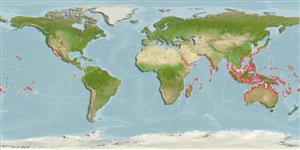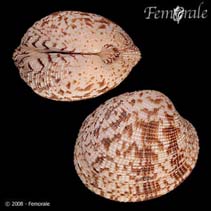Periglypta reticulata (Linnaeus, 1758)
Reticulated venus| Native range | All suitable habitat | Point map | Year 2050 |

|
| This map was computer-generated and has not yet been reviewed. |
| Periglypta reticulata AquaMaps Data sources: GBIF OBIS |
Classification / Names Common names | Synonyms | CoL | ITIS | WoRMS
| Venerida | Veneridae
Environment: milieu / climate zone / depth range / distribution range Ecologia
; intervalo de profundidade 0 - 25 m (Ref. 348), usually 0 - 25 m (Ref. 75831). Tropical
Distribuição Países | Áreas FAO | Ecossistemas | Ocorrências | Introduções
Indo-Pacific: from East Africa, to eastern Polynesia; north to Japan and Hawaii, and south to Queensland.
Length at first maturity / Tamanho / Peso / Idade
Maturity: Lm ? range ? - ? cm Max length : 9.0 cm SHL macho/indeterminado; (Ref. 348); common length : 7.5 cm SHL macho/indeterminado; (Ref. 348)
Locally collected for food in the area (Ref. 348). Found in intertidal areas in sand and mud (Ref. 75831). Also in sublittoral zone (Ref. 345).
Life cycle and mating behavior Maturidade | Reprodução | Desova | Ovos | Fecundidade | Larvas
Members of the class Bivalvia are mostly gonochoric, some are protandric hermaphrodites. Life cycle: Embryos develop into free-swimming trocophore larvae, succeeded by the bivalve veliger, resembling a miniature clam.
Referência principal
Referências | Coordenador | Colaboradores
Poutiers, J.M. 1998. (Ref. 348)
Categoria na Lista Vermelha da IUCN (Ref. 130435)
Categoria CITES (Ref. 108899)
Not Evaluated
CMS (Ref. 116361)
Not Evaluated
Ameaça para o homem
Harmless
Utilização humana
| FishSource |
Ferramentas
Mais informação
Fontes da internet
BHL | BOLD Systems | CISTI | DiscoverLife | FAO(Publication : search) | Fishipedia | GenBank (genoma, nucleotídeo) | GloBI | Gomexsi | Google Books | Google Scholar | Google | PubMed | Árvore da vida | Wikipedia (ir para, procurar) | Registo zoológico
Estimates based on models
Preferred temperature
(Ref. 115969): 24.3 - 29.1, mean 28 (based on 1594 cells).



